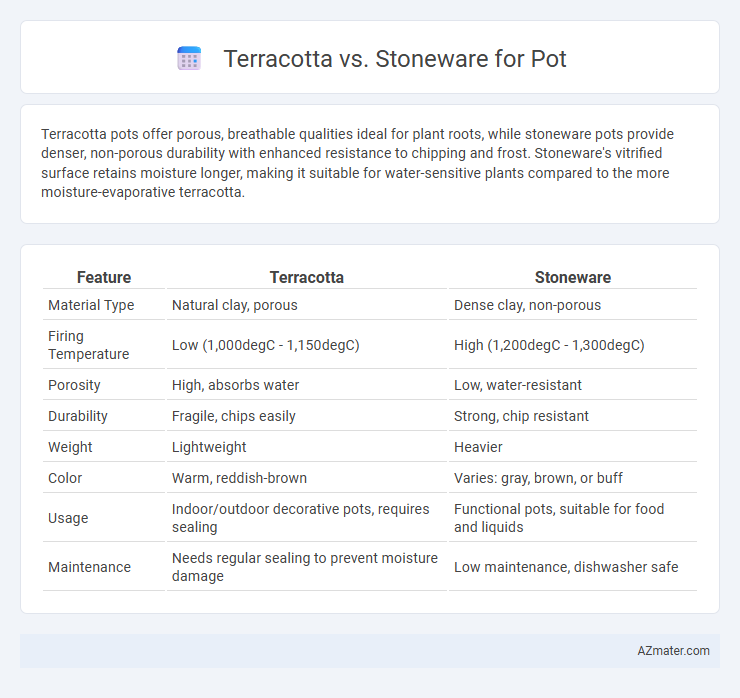Terracotta pots offer porous, breathable qualities ideal for plant roots, while stoneware pots provide denser, non-porous durability with enhanced resistance to chipping and frost. Stoneware's vitrified surface retains moisture longer, making it suitable for water-sensitive plants compared to the more moisture-evaporative terracotta.
Table of Comparison
| Feature | Terracotta | Stoneware |
|---|---|---|
| Material Type | Natural clay, porous | Dense clay, non-porous |
| Firing Temperature | Low (1,000degC - 1,150degC) | High (1,200degC - 1,300degC) |
| Porosity | High, absorbs water | Low, water-resistant |
| Durability | Fragile, chips easily | Strong, chip resistant |
| Weight | Lightweight | Heavier |
| Color | Warm, reddish-brown | Varies: gray, brown, or buff |
| Usage | Indoor/outdoor decorative pots, requires sealing | Functional pots, suitable for food and liquids |
| Maintenance | Needs regular sealing to prevent moisture damage | Low maintenance, dishwasher safe |
Introduction: Terracotta vs Stoneware Pots
Terracotta pots are made from natural clay fired at lower temperatures, resulting in a porous, breathable material ideal for plants needing good aeration and drainage. Stoneware pots are crafted from denser clay fired at higher temperatures, offering durability, water resistance, and a smoother finish suitable for a wide range of indoor and outdoor plants. Choosing between terracotta and stoneware depends on factors like moisture retention, durability, and aesthetic preferences for gardening or decorative use.
Material Composition of Terracotta and Stoneware
Terracotta pots are made from porous, low-fired clay rich in iron oxide, giving them their characteristic reddish-brown color and breathability that aids moisture regulation for plants. Stoneware is crafted from a denser, non-porous clay fired at higher temperatures, resulting in a vitrified, durable material resistant to water and temperature fluctuations. The distinct material compositions influence their weight, porosity, and durability, making terracotta ideal for plants requiring good airflow and stoneware suited for longevity and frost resistance.
Durability Comparison: Strength and Longevity
Stoneware pots exhibit superior durability compared to terracotta, boasting higher strength and enhanced resistance to cracking under impact or temperature fluctuations. Terracotta, while porous and aesthetically pleasing, is more prone to chipping and weathering over time, especially in freeze-thaw climates. The dense, vitrified composition of stoneware ensures greater longevity, making it a more robust choice for long-term outdoor or heavy-use applications.
Porosity and Water Retention Capabilities
Terracotta is highly porous, allowing it to absorb and retain water effectively, which benefits plants requiring well-drained soil but demands frequent watering. Stoneware has a much lower porosity due to its dense, vitrified structure, resulting in superior water retention and less evaporation, suitable for moisture-loving plants or indoor use. The key difference lies in terracotta's breathable nature promoting aeration versus stoneware's sealed surface providing consistent moisture.
Weight and Ease of Handling
Terracotta pots are significantly lighter than stoneware, making them easier to handle and move, especially for larger sizes. Stoneware is denser and heavier, providing increased durability but requiring more effort during transport and placement. For gardeners prioritizing ease of handling and mobility, terracotta is the preferred material due to its lightweight nature.
Aesthetic Appeal and Surface Texture
Terracotta pots boast a warm, earthy red-orange hue with a porous, matte surface that enhances rustic and natural garden aesthetics. Stoneware pots feature a denser, smoother texture with a range of muted to glossy finishes, providing a more refined and modern look. The rough, slightly grainy feel of terracotta contrasts sharply with the sleek, often vitrified surface of stoneware, influencing the tactile and visual appeal in different landscaping or interior design contexts.
Suitability for Indoor and Outdoor Use
Terracotta pots provide excellent breathability and natural insulation, making them ideal for indoor plants that require moderate moisture levels but may crack under extreme outdoor weather conditions. Stoneware pots offer superior durability and frost resistance, suited for both indoor and outdoor use, especially in climates with fluctuating temperatures. The glazed surface of stoneware enhances water retention, reducing the need for frequent watering in outdoor gardens.
Price Comparison: Budget Considerations
Terracotta pots typically offer a more affordable option, with prices often 30-50% lower than stoneware counterparts due to less intensive manufacturing processes. Stoneware, made from refined clays and fired at higher temperatures, commands higher prices but provides superior durability and aesthetic appeal. Budget-conscious buyers prioritize terracotta for cost efficiency, while those valuing longevity may invest more in stoneware despite the higher initial expense.
Best Uses: What Each Type Excels At
Terracotta pots excel in breathability and moisture regulation, making them ideal for plants that prefer dry conditions, such as succulents and cacti. Stoneware pots are highly durable and non-porous, providing excellent resistance to frost and retaining moisture well, which suits plants requiring consistent hydration like ferns and tropical species. Choosing between terracotta and stoneware depends on the plant's water needs and environmental exposure, with terracotta favoring well-drained, arid settings and stoneware fitting wetter, colder climates.
Care, Maintenance, and Longevity Tips
Terracotta pots require regular sealing and careful drying to prevent cracking and water absorption, while stoneware is inherently more durable and less porous, reducing maintenance needs. Cleaning terracotta involves gentle scrubbing to remove mineral deposits without harsh chemicals, whereas stoneware can withstand more rigorous cleaning methods. For longevity, storing terracotta pots indoors during freezing temperatures is essential, but stoneware pots generally endure outdoor conditions better due to their vitrified nature.

Infographic: Terracotta vs Stoneware for Pot
 azmater.com
azmater.com